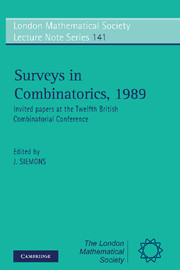Book contents
- Frontmatter
- PREFACE
- Contents
- On the theory of designs
- Designs: mappings between structured sets
- Developments based on Rado's dissertation ‘Studien zur Kombinatorik’
- Designs and automorphism groups
- On matchings and Hamiltonian cycles in random graphs
- Decompositions of complete bipartite graphs
- On the method of bounded differences
- On the use of regular arrays in the construction of t-designs
- The ‘Snake Oil’ method for proving combinatorial identities
The ‘Snake Oil’ method for proving combinatorial identities
Published online by Cambridge University Press: 05 August 2013
- Frontmatter
- PREFACE
- Contents
- On the theory of designs
- Designs: mappings between structured sets
- Developments based on Rado's dissertation ‘Studien zur Kombinatorik’
- Designs and automorphism groups
- On matchings and Hamiltonian cycles in random graphs
- Decompositions of complete bipartite graphs
- On the method of bounded differences
- On the use of regular arrays in the construction of t-designs
- The ‘Snake Oil’ method for proving combinatorial identities
Summary
I have recently been working on a book about generating functions. It will be called ‘Generatingfunctionology,’ and it is intended to be an upper-level undergraduate, or graduate text in the subject. The object is to try to impress students with the beauty of this subject too, so they won't think that only bijections can be lovely.
In one section of the book I will discuss combinatorial identities, and the approach will be this. First I'll give the ‘Snake Oil’ method, in the spirit of a unified approach that works on many relatively simple identities. It involves generating functions. Second, I will write about a much more powerful method that works on ‘nearly all’ identities, including all classical hypergeometric identities and many, many binomial coefficient identities.
These two approaches will be mirrored here, in that this article will mostly be about the Snake Oil method, whereas the talk that I will give at the conference will be about the much more powerful method of WZ pairs [WZ], which at this writing is still under development. A brief summary of the WZ results appears in section (II) below.
Aside from these developments, there have been other unifying forces at work in the field of identities. The expository paper of Roy [Ro], shows how even without a computer one can recognize many binomial identities as cases of just a very few identities in the theory of hypergeometric series. The work of Knuth [Kn] shows how a few rules about binomial coefficients and their handling can, in skilled hands, prove many difficult identities.
- Type
- Chapter
- Information
- Surveys in Combinatorics, 1989Invited Papers at the Twelfth British Combinatorial Conference, pp. 208 - 217Publisher: Cambridge University PressPrint publication year: 1989
- 2
- Cited by

